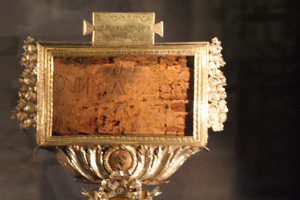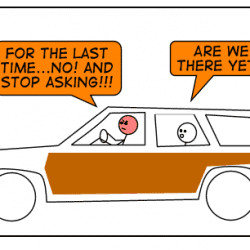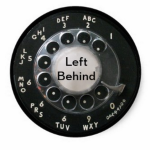In the final days of the campaign to raise the funds to self-publish my novel, Blood Doctrine, I’m sharing early chapters in the manuscript in rough form so folks can get a sense of the story. We’re nearly two-thirds of the way to our goal, with less than six days to go. Thanks for any help you can offer in backing the project and spreading the word!
Click Here to read more about the Kickstarter campaign.
 “Hey Nica,” said Edward, the crusty, stout New Yorker editor twenty years her senior, “what’s a six-letter word for ‘vagabond?’” Nica maintained her gaze, fixed on the screen before her.
“Hey Nica,” said Edward, the crusty, stout New Yorker editor twenty years her senior, “what’s a six-letter word for ‘vagabond?’” Nica maintained her gaze, fixed on the screen before her.
“Harlot,” she answered.
“I thought that was a prostitute,” grunted Edward, tossing a handful of sunflower seeds into his mouth. Since his wife put him on a diet, he replaced the M & M’s on his desk with something far more labor-intensive and equally unsatisfying. For a few days, he stuffed the shells in his cheek like a rodent, sucking on them one at a time and cracking them between his molars. Soon he grew weary of the process and began devouring them, shells and all.
“That’s what it means now,” said Nica, pulling her chestnut hair into a ponytail. “It used to mean someone without roots. After that, it referred to a male libertine.”
“You’re making that up,” said Edward, picking at a splintered shell from between his teeth.
“Over time,” she continued, “it became a deprecating word for women.”
“No shit.”
“It’s not that surprising really,” said Nica, pulling out her Oxford Dictionary of English Etymology. “Do you know how many sexually derogatory words there are for women in the English language?”
“No,” sighed Edward, “but I’m afraid you’re about to tell me.”
“A hell of a lot more than there are for men,” she slid the dense volume across the desk toward him, more to emphasize her point than out of an expectation that he would challenge her claim.
“I should know better than to ask a woman with a degree in feminist literature about words,” said Edward. “Yet another testicular power conspiracy revealed.”
“It all comes down to sex and power,” smiled Nica. “Throughout history, men have used power to get sex, and women have used sex to get power.”
“Sadly,” said Edward, grabbing another handful of seeds, “I have no prospect of either.”
“You doing a story?” asked Nica. Edward lifted a folded newspaper he had resting on his lap.
“New York Times crossword,” admitted Edward. “I figured you’d know the answer. Just didn’t expect a lecture.”
“You just got lucky,” said Nica. “I happened to learn plenty about harlots in my graduate class on women in the Bible.”
Nica was fascinated with the genealogy of Jesus, particularly regarding the differences between the lineages outlined in the gospels. While doing research for a college paper, she discovered that many scholars believed the account in Luke actually was referring to the bloodline of Mary, but because maternal lineage was not considered valid, the name ultimately was changed to Joseph. With some further digging, she learned that ancient DNA samples, such as those found occasionally in ancient ossuaries and other Middle Eastern artifacts, generally were traceable only through the maternal bloodline.
“Whereas ancient literature’s legacy is the celebration of the families of our fathers,” Nica once wrote in her weekly newspaper column at the Dallas Morning News, “science confounds such hegemony with hard evidence, left behind by the enduring genetic legacy of women.” Nathan, her managing editor at the News, had dressed her down on two counts for that article. Not only was she stirring up a relative hornet’s nest by spouting feminist ideology in one of the Bible Belt’s most prominent papers, but she did it in a way, using such words as ‘hegemony,’ that simply made the general readership feel ignorant.
“Is it my fault if the average reader has the vocabulary of a seventh-grader, and the critical thinking skills of my niece?” argued Nica.
“No,” said Nathan, “of course not. But it is your fault if those same people stop buying our paper because of what you write.” Despite their occasional clashes, Nathan afforded Nica a relatively wide berth to explore more controversial matters in her Saturday section. Though he often did not agree with her, Nathan respected her, which she deemed was more important. In fact, he had been the one to recommend her for the New Yorker job, for which she was grateful.
Click Here to read more about the Kickstarter campaign.
At the New Yorker, where it was common practice to challenge readers to reach for their thesaurus, and where East Coast principles were more tolerant of her sort of bent, she had sufficient creative room to breathe. Edward, Nica’s boss at the New Yorker, was more of a partner than a supervisor. The egalitarian climate was the perfect environment for a strong personality like hers, and her budget was significantly larger than at the News. Instead of being responsible for several rudimentary pieces a week, Nica was expected to produce more detailed investigative stories about organized religion, generally given four to six weeks to complete an article of several thousand words.
Despite his abrasive, terse mannerisms, Edward rarely shot down Nica’s ideas. In general, it was assumed that if you had the chops to make it onto the New Yorker staff, you no longer needed a mother hen hovering over your shoulder, checking grammar and word counts.
Though the magazine projected an image of austerity and elegance, the inner sanctum of the Lions’ Den, as the main editorial floor was called, was cluttered, noisy and dimly lit. Desks were crammed together in clusters of four around knotted tangles of computer cables and phone lines. Televisions, mounted on support columns, murmured in a hypnotic drone throughout the day on the respective news channels.
Edward, a staple of the Lion’s Den, was the archetypal New York editor. He downplayed his intellectual acuity with a disheveled wardrobe and bowling-league physique. Nica suspected Edward had more than professional feelings for her, though he never did anything to violate her trust or make her uncomfortable. He was more of an adoring father figure than a potential suitor, and though he complained benignly about his marriage, he and his wife had been faithful to one another for three and a half decades.
One of the greatest, and most ironic, drawbacks of her career as a religion writer was that Nica adorned herself with the pessimistic mantle of a journalist so often that her faith meshed clumsily with her fierce pragmatism, which was at the heart of her gifts as a reporter. Though she had expected that life as a religion writer would strengthen her theological resolve, she seemed instead to question her own beliefs more every day.
Despite her cynicism, she had pursued her share of cold leads too far, especially early in her time at the newspaper. Perhaps the most infamous case was when she spent three months investigating a rumored group known only as The Project. Some with whom she spoke believed they were related to the Merovingians, who were the heirs of an ancient French dynasty, mythologized as protectors of the supposed bloodline of Jesus. Others believed they were involved in genetic engineering experiments such as cloning, and still others were confident The Project was a post-apocalyptic survivalist cult. Nica’s travel stipend from the paper ran out in a little over two months, but she used her own money and the balance of her vacation to continue the pursuit. In the end, the quest yielded nothing but more anecdotes and unverifiable conjecture, as well as some hard-earned wisdom for the young reporter.
Nica was just finishing up a story about a botanist in Israel who had nurtured some recently discovered date palm seeds back to life after two thousand years of dormancy when she received an email from Gordon, a colleague in Boston. The heading read, “Essene relic revisited – what do you know?” Gordon was well connected in gossip circles, but as a tabloid reporter, he hardly had the juice to make the real contacts necessary for hard news stories. When he had a lead and wanted to find out more, he usually sent it on to Nica.
This particular rumor indicated that a name plate from an ancient crucifixion had been discovered in the Qumran caves where the ancient, mysterious Jewish sect known as the Essenes had lived. The find was made in 1948, the year following the discovery of the Dead Sea Scrolls in the same network of caves. The existence of the scrolls led to an intense excavation of the entire area, which led to hundreds of other artifacts being found, each of varying degrees of historical significance. Some offered clues about the enigmatic Essenes, about which the modern world knew very little but speculated greatly.
The name plate was argued to bear remnants of the title bestowed upon Jesus at the time of crucifixion: “King of the Jews.” However nay-sayers were quick to discredit the find on a number of grounds, and there was little enough available at the time to refute the overwhelming arguments against its authenticity. Instead of being further examined, it was placed in the care of the Israeli Antiquities Authority, warehoused along with tens of thousands of other artifacts in a set of enormous storehouses.
Click Here to read more about the Kickstarter campaign.
Gordon’s paper was running a piece in their upcoming edition implying that the relic was indeed authentic. As usual, they had no scientific basis for their claim, but they spun an intriguing story about connections between the name plate and the ossuaries found in the Jesus Tomb, recently popularized by a sensational documentary on the subject. Clearly, Nica mused, they were grasping at anything to cash in on the fervor surrounding the film and subsequent book. However, she determined that doing an investigation piece on the supposed connection might make for an interesting story of her own. If nothing else, she could write a response to the tantalizing claims that surround the tombs and the ossuaries found there, dispelling yet another emerging religious myth.
“Thanks for the tip G-man,” wrote Nica. “I’ll give my guy at the I.A.A. a call and see what he has to say. Will let you know once I have something worth sharing.”
Nica had met Ibrahim at a conference on Biblical artifacts in New York, where he presented a paper on advances in artifact tracking using computer technology. It was not her particular area of interest, but the two struck up a friendship that spanned the continents upon his return to Israel. He had begun his work at the Israel Antiquities Authority as a clerk more than fifteen years prior. Now he was the director of recording and cataloguing. She imagined his daily routine to be dreadfully monotonous and lifeless, although he was always ebullient when she called. Whether it was his normal disposition or if his mood lifted because of her calls, she was not sure.
“Nica, my dear,” said Ibrahim, “it has been too long since we last spoke.”
“I know. It really has. How are you doing?”
“God blesses me every day,” said Ibrahim. “I have two beautiful sons, and my wife is pregnant with our third child.”
“Wow,” exclaimed Nica. “It doesn’t seem like it’s been that long. You work fast.” Ibrahim let forth a raspy, abdominal laugh.
“I have been traveling less,” he said, “which means I have spent more evenings at home.” He laughed again.
“Send me some pictures?”
“Of course,” said Ibrahim. “Now, although I could talk about my family all day long, my guess is you didn’t call from New York to inquire about my children.”
“Actually, I have some questions about something you have in your catalog.” She explained the lead she received from Gordon, and Ibrahim interjected before she could finish her story.
“Ah, yes,” he said. “You’re referring to the titulus crucis.”
“I’m not sure about the Latin,” said Nica, “but that sounds right. Do you know how to get some information on it?”
“Actually,” said Ibrahim, “I have the file on my desk. You’re the fourth person to call about it this week. Every time I start to put the file back, someone else asks about it.” Nica grimaced.
“I know I shouldn’t ask, but–”
“No, no reporters,” he assured her. “You’re the first. Only a couple of academics and one of the administrators at the Vatican.”
“Thanks Ibrahim,” she said. “I’m curious about any records of samples taken from the–”
“Tilulus crucis,” said Ibrahim. “It means ‘Title of the Cross.’”
“Any chance you can tell me who has taken samples from the titulus crucis?” There was silence on the other end of the line, followed by a muffled voice. After several seconds, Ibrahim removed his hand from the receiver.
“Give me your fax number,” he said in a subdued voice, “and a couple of hours.”
“Ibrahim,” said Nica, leaning back in her chair, “you’re a prince.”
“One thing,” warned Ibrahim, “you never got anything from me. Understand?” His voice was uncharacteristically grave.
“I understand,” Nica assured Ibrahim, “I won’t forget it, seriously.” She gave him her fax number and hung up the phone.
“What the hell’s the matter with you?” asked Edward, dumping the rest of the sunflower seeds from his desk into the trash. “Somebody die or something?”
“I’m not sure,” said Nica, “I think I just need to eat something. You hungry?”
“That goes down as one of the top five dumbest things anyone’s ever asked me,” said Edward. “What do you think?”
When Nica got back from lunch, the fax was sitting on her desk. The source number was blocked, and there was no cover letter. There was no reference to the titulus crucis on the page: only her name scribbled at the top, followed by three more names, professional affiliations and dates. The first sample was taken in 1981, the year the titulus was discovered. The recipient was Dr. Binyamin Abijah from PaleoTech Labs, a contractor for the I.A.A. They were commissioned with authenticating newly found artifacts. The most recent date was a month prior, registered by a man named Dr. Vaughan Pavel from the Max Planck Institute in Leipzig. The third, registered to Dr. Damian Armitage from Pennsylvania State University, was taken in June, 1985.
“I’ll be damned,” said Nica.
“Something wrong?” said Edward, glancing up from his crossword.
“I don’t know for sure,” she said, turning toward a nearby window, yellowed with years of Manhattan pollution. “I think I need to take a trip to Pennsylvania.”











